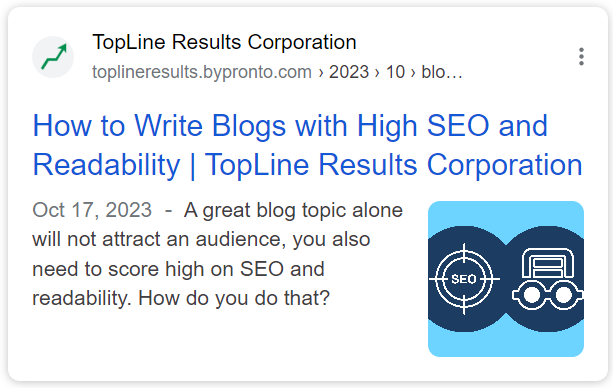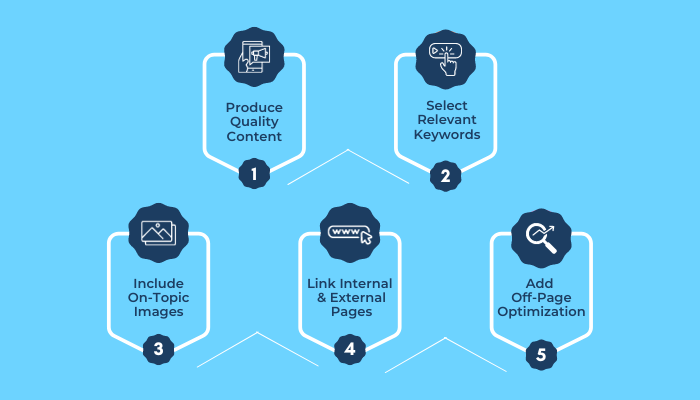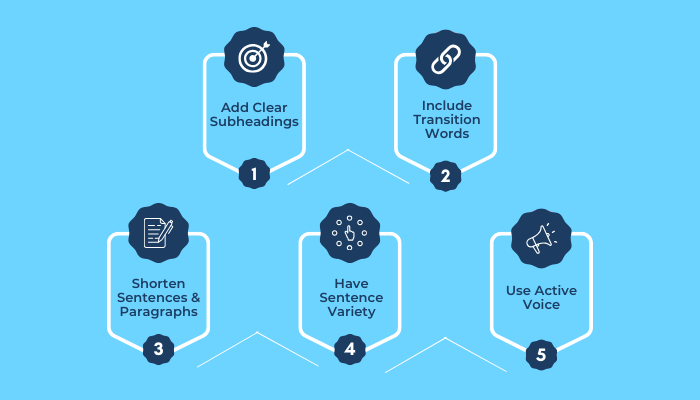A great blog topic alone will not attract an audience; you also need to score high on SEO and readability. Why is that? Well, search engines like Google need to like, understand, and believe your blog has the most relevant content to recommend to its users. Now, how does it do that? It relies on webpage optimization and clarity of your text. If you meet all the criteria search engines are looking for, your page will get more visibility and attract your intended audience.
What is SEO?
SEO or Search Engine Optimization is the process of improving web content to make a website more visible and relevant when users search for keywords on Google or other search engines. Google alone gets over 8.5 billion searches per day, so it is important to optimize your content, links, and use target keywords to improve your ranking position. If done correctly, this process will significantly increase organic traffic to your page(s). In other words, you will attract more of your ideal customers for free. This should drive more relevant connections and conversions.
SEO can be done both on your page and off. On-page SEO includes having quality content, relevant keywords, and images, using internal and external links, and writing a clear title and meta description. Off-page SEO is the process of getting other sites or pages to backlink to the page or content you want optimized. Whether your goal is to increase your brand or online presence, generate more leads, or boost sales, SEO is a great solution.
How to Improve SEO in Blogs:
Quality Content
Creating long, high-quality blogs of 1000 words or more has a greater chance of ranking well with Google. This is simply because there is more text to help determine the topic of your blog. The minimum word count for a blog is 300 words. However, the less text you have the more likely your ranking will be lower. This is because Google will view it as thin content – or content that has no value to the user. You need to remember the goal of search engines is to provide the best answers to the queries people have.
Keywords
A keyword or keyphrase is typically a topic or combination of words people use when searching for information on Google or other search engines. Relevant keywords reflect the main topics of your content and should be found various times throughout your page. For your content to be discoverable when users are looking for the topic of your blog, you need to input focus keywords on the backend of your web hosting site. It is recommended you use unique focus keywords for each page, otherwise when people are searching for “SEO & readability”, for example, your pages will be competing with each other among all the other webpages out there with the same keyphrase. So, if you do happen to write another blog about SEO or readability, try selecting related keywords like “SEO techniques to enhance readability”. This will help you rank higher and possibly generate more traffic the less competition you have.
Here are all the places you should add your keyword/s:
- In the title
- In the first or second sentence of your blog (This is because Google and other search engines read your introductions to learn about the topic of your blog. It is also helpful for your readers to understand what your blog is about with a clear, informative introduction)
- Throughout your blog, making up .5 to 3% of your text
- In your blog images alt attributes
- In your URL
- In your Meta Description
- In some of your subheadings
Images
Having high-quality and on-topic images in your blog not only engages the user while reading your blog but can attract people to it! If you optimize the image by adding your keyword to the alternative text describing what the image is, you will rank higher when people do a Google image search on your blog topic.
Internal & External Links
Internal links take readers from one page on your website to another. This means you are keeping a user on your website helping them navigate to similar or other relevant content. External links take readers from one website to another. Typically, you will use these to link to other resources. Both links boost the perceived experience and trustworthiness of your content, which helps your SEO ranking.
Title & Meta Description
An SEO page title is the first text a user sees in search results. Under the title is the meta description, which is a brief summary of the content on the page. Both play a significant role in increasing SEO, because it is what encourages users to click on a page and helps search engines determine what the page is about. That is why it is recommended to include your keyword/s in both places. While there is no limit for the length of your title or description, it’s important to consider that search engines have a width restriction. This means that roughly 57 characters of your title and 155 characters of your meta description will be displayed, so it is recommended to keep your text around those limits.
page and helps search engines determine what the page is about. That is why it is recommended to include your keyword/s in both places. While there is no limit for the length of your title or description, it’s important to consider that search engines have a width restriction. This means that roughly 57 characters of your title and 155 characters of your meta description will be displayed, so it is recommended to keep your text around those limits.
What is Readability?
Readability refers to how clear, entertaining, and easy your text is to read by its intended audience. The more readable your text is, the more likely it is to keep readers on your website. Also, search engines are now more advanced in analyzing the quality of text based on the chosen keyword. This is because it wants to provide the most relevant and trustworthy information to its users. So, it’s worth spending the time to make your text relevant and enjoyable to read. To increase your readability score, look at your use of subheadings, transition words, sentence and paragraph length, sentence variety, and overall voice of the text.
How to Improve Readability in Blogs:
Subheadings
Subheadings are simply clear titles for your paragraphs. They help readers easily find the content they are looking for and help search engines understand your text. Ideally, each section or paragraph over 300 words needs a subheading. This is to prevent information overload and make it easier for readers to pinpoint information.
Transition Words
Using transition words is great for connecting the ideas within your text. It's also a key factor in scoring high on readability. As a result, they help the flow of your text and make it easier for the reader to understand and stay engaged. Not every sentence needs to start with a transition word. However, including a transition word in at least 30% of your sentences will improve your readability score and contribute to higher SEO.
Sentence & Paragraph Length
Think about when you are searching for an answer. Do you want something long and difficult to process or short and to the point? Your readers want quick answers, so your sentences and paragraphs shouldn’t be overwhelmingly long. To score high on readability, it is recommended that 75% of your blog contains sentences with less than 20 words. Additionally, if your paragraph is approaching more than 150 words, you should break up your text into two sections. By doing this, your text will be easier to scan and more valuable to the reader.
Sentence Variety
Let’s say you are writing about sentence variety, and every sentence starts with “sentence variety”, wouldn’t that be a lack of sentence variety? If that was kind of awkward to read, it’s because using the same word over and over is boring. To help increase your readability and make your content more engaging, you should actively write with a variety of sentence structures and vocabulary. This will add to your rich content and improve your readers’ experience.
Voice
Which option below is better in terms of readability?
- Active voice increases readability.
- Readability will be increased by using an active voice.
The first sentence uses an active voice and is clear and concise. The second sentence uses a passive voice resulting in wordiness and complexity. Generally, a passive voice can be more challenging for readers to process, so it is recommended to keep your usage below 10% to achieve high readability.
Conclusion:
If you want to write better blogs, aside from writing relevant content, you need to consider the technical aspects of constructing your blog when it comes to SEO and readability. Both are essential to improving your blog’s visibility and attracting your ideal audience at no additional cost. By optimizing your website through on-page and off-page strategies, you can tap into the billions of daily Google searches. Additionally, with improved readability, you will rank higher in search engines and retain readers because your content provides value in a clear and engaging way. So, if you want to write better blogs to boost your brand, attract your ideal audience, or increase sales, a combination of the SEO and readability tips mentioned above will get you there!
If you have additional questions on how to improve your website SEO or readability, contact TopLine Results marketing team at info@toplineresults.com ! It’s our mission to help you optimize your strategy to see measurable results.




Leave a comment!
You must be logged in to post a comment.